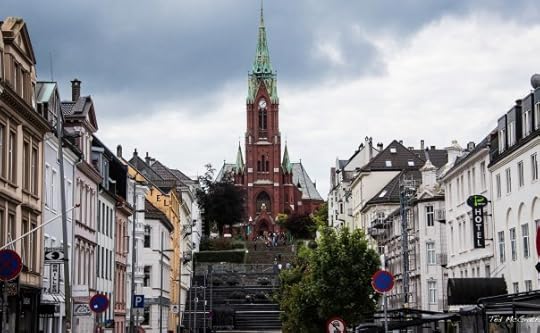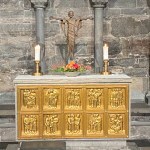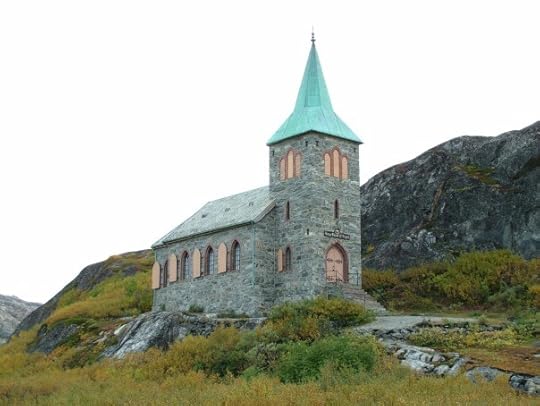5 old churches in Norway: Lessons for now
I have spent a lot of time learning the history of the world, focusing on the church. All my study did not prepare me for Trump — it should have. But no matter how many similar leaders I find in the past, I still wonder, “How did a Trump inspire crusaders?”
How did the U.S. get to the place where Speaker of the House Mike Johnson would give public glory to God for final passage of the “big beautiful bill,” while other religious leaders decried the legislation as un-Christian, un-American, evil and dangerous?
But it happened. On July 3, after the House passed the bill in a process known as “reconciliation” with the Senate version, Johnson tweeted, “Soli Deo Gloria,” or “Glory to God alone,” followed by a Bible verse from 2 Corinthians 5:18 — “All this is from God, who reconciled us to himself through Christ and gave us the ministry of reconciliation.”
Believe it or not, he was comparing the reconciling love of God Christians know as the source of life to the Congressional process of budget reconciliation the Senate uses to avoid compromises over legislation — in this case, legislation evangelical Christians support but many other Christians do not.
Over and over throughout history, people have followed wicked leaders and have used those leaders to represent and fulfill their own hateful agendas even as they were deluded and used by the despot for his. But over and over again, true believers have worked out their faith, speaking and acting out their convictions in confusing and threatening situations.
We saw both realities in Norway, represented in some fascinating, historic church buildings. Our trip has been, among other things, a living lesson on how the church has failed to and follow Jesus — but also brilliantly succeeded. We visited five churches in four locations as we cruised up the coast that told us old tales with urgent lessons for today.

We had quite a bit of time to spend in Bergen, the gateway city to the fjords. We were wandering around on Sunday and climbed up steps to an old, monumental church sheathed in material masking its rehab. It was St. John’s Church, built in 1894, an impressive neo-Gothic building known for having Bergen’s highest tower
We found our way into the building just in time to kneel with the locals at the altar and hold out little silver cups as the pastor gave us bread and a deacon poured us sweet wine from a common pitcher. It was beautiful.
68.7% of Norwegians were members of the state sponsored and funded Church of Norway as of the end of 2019. However, only 20% of Norwegians say that religion occupies an important place in their lives according to Gallup, which makes Norway one of the most secular countries of the world. Only about 3% of the population attends church services or other religious meetings more than once a month.
The old church building and their church were falling apart but we were welcomed by a kind-faced mother attending with her two 20-something sons sitting in the back with us holding on to the faith. The whole thing struck me as beautiful.

 The mother church of the church of Norway in Trondheim, the cathedral, Nidarosdomen, was much less beautiful — although I found a marvelous statue of Francis of Assisi to inspire my memory of him leading up to his day last week.
The mother church of the church of Norway in Trondheim, the cathedral, Nidarosdomen, was much less beautiful — although I found a marvelous statue of Francis of Assisi to inspire my memory of him leading up to his day last week.
Nidaros Cathedral was built over the burial site of St. Olav, the Viking king who became Norway’s national saint. Olav Haraldsson was born in the 990s. As a young boy, he went out “viking” (on sea expeditions). His travels took him to England, where he fought in the army of King Ethelred. In France, he spent two winters in Prince Richard’s court in Normandy. During his stay in Normandy, Olav was tutored in the Christian faith, and he was baptised in Rouen in 1014.
Olav returned to Norway the following year, with the goal of uniting the country as a Christian kingdom under his rule. He justified his right to the throne by claiming he was a descendant of King Harald Hårfagre (Harald I Fairhair). He was affirmed by the assemblies. By 1024, Christianity became the official religion in Norway.
Olav had powerful opponents among Norwegian noblemen, and his brutal actions made him unpopular. When King Knut of Denmark seized the country in 1028, Olav fled to his brother-in-law in Gardariket. He returned two years later to regain power but was stopped by a large peasant army led by Norwegian noblemen. On July 29, Olav was killed at the Battle of Stiklestad
If you watch Vikings Valhalla you will see another version of Olaf plotting to kill pagans. The creators do not have him die in battle but by the hand of Lief Erickson’s sister who is the living icon of the old ways and old gods
After the battle, Olav’s corpse was transported to Nidaros and buried at the edge of the River Nidelva. Soon people began telling stories of miracles that occurred around the king’s grave. One year and five days after the battle the grave was opened, and Olav was canonized as a saint. Those who were present said that the king looked as though he was sleeping. The corpse was unchanged, but his hair and nails had grown.
The saint’s body was placed in a beautiful silver casket. The casket was first taken to Clemens Church but was later moved to the church that was built over his tomb. Here it stood by the altar through most of the Middle Ages. The stories of Olav’s miracles spread across Norway and the rest of Europe, and the saint’s tomb became one of the most important pilgrimage sites in Northern Europe. The church’s bio says
St. Olav is often depicted wearing a crown and holding an axe, with a dragon beneath his feet. The crown symbolises that he is Norway’s eternal king. The axe shows his authority as a just legislator, but it is also the tool that took his life. The dragon can be interpreted in several ways, both as an image of Satan and the evil that the king defeated. Perhaps it also depicts the king’s own sinful life.
Nationalism led by bloodthirsty men never works out. When lies are enshrined, true faith is undermined. No one can kill it, but a murderous, mythic leader is the worst of all diseases. Venezuelans murdered in their boats and toddlers in zip ties are just the beginning.

At the surprising town of Tromso we visited the dramatic parish church in the new part of town across the bridge from the old city. It is called the “Arctic Cathedral” in the tourist brochures. It is not a cathedral but it does evoke the snowy peaks of the “northland.” We somehow had no idea the territory above the arctic circle was so beautiful.
We enjoyed meeting our taxi driver from Somalia and walking back over the dramatic bridge. But the church was not really a good tourist destination for bus loads of tour groups finding something to do.
For a Jesus follower, however, it is an oasis of beauty and inspiration. The year I graduated from high school in 1972, Victor Sparre replaced the clear panes that had framed the city view with his most important work of glass art. It depicts the hand of God from which three luminous rays emanate; one through Jesus, one through a woman and one through a man. As the sun rises, a soaring Christ bedazzles in cobalt blues and golds.
The longing for Jesus to rise again among us is persistent in any age among Christians. But the Evangelicals are especially stirred up with thoughts of the second coming, I hear, just like they were in 1972. They have a wounded antichrist seizing power and are wearing hats on their foreheads to mark their obedience. So maybe they are right this time.
I was happy to wander into a striking piece of architecture and art in the middle of what I used to think of as nowhere. Jesus manages to meet me wherever I turn.
Kirkenes: Religion used as a nationalistic propOur turnaround spot on our cruise was Kirkenes, just miles from the Russian border and not far from Murmansk, where the nuclear subs live – the old ones are hazardous waste, the new ones are ready to lay waste. It is a dangerous area. Our guide begged us not to get cute with the border crossing.
Two churches in the area serve as cautionary tales from Christians caught in the nationalist urges of their leaders.
 Boris and Gleb Chapel
Boris and Gleb ChapelIn 1826, the demarcation of the Norway–Russia border was completed. The border was set as the Pasvik River. But there is an exception as the river nears the mouth because an old Russian Orthodox chapel was on the wrong side.
After the agreement there were still disputes between the Norwegian authorities and Russian fishermen. After further confrontations, the County Governor of Finnmark called on a ship from the Royal Norwegian Navy to show some force during the heaviest fishing months.
 King Oscar II Chapel at Grense Jakobselv.
King Oscar II Chapel at Grense Jakobselv.In 1851, the Interior Ministry sent an independent investigator who did not share the governor’s views on a solution. He proposed instead to erect a chapel at Grense Jakobselv. A Lutheran chapel would be a boundary marker, in the same way the Russian Orthodox chapel of Boris Gleb had been used for border demarcation in 1826. In the summer of 1869, the new chapel was finally built.
In 1873, King Oscar II of Sweden and Norway visited the chapel. To commemorate this visit, he bestowed this chapel with a marble slab with the bilingual inscriptions: Kong Oscar II hørte Guds ord her den 4de Juli 1873 (Norwegian language) and Gonagas Oscar II gulai Ibmel sane dobe dam 4 ad Juli 1873 (Northern Sami language) which means “King Oscar II heard the words of God here on the 4th of July 1873.”
 Mitrofan at Boris Gleb Church
Mitrofan at Boris Gleb ChurchAccording to The Barents Observer, in 2023, when Mitrofan, the Metropolitan of Murmansk, visited Boris Gleb church, he had a nationalist agenda. He was reasserting that Borisoglebsk, the Russian exclave on the western shore of the Pasvik River is holy land — the four square kilometre area where the Church of Boris and Gleb stands is a sanctuary honoring two Orthodox saints who were killed in Kievan Rus in the 11th Century.
He was memorializing the martyrs by connecting them with the present martyrs being killed by godless Ukrainians from Kiev. Mitrofan has made himself a leading spiritual proponent of his country’s bloody onslaught on the neighboring country.
In 2022 he said, “Orthodoxy is the only force of God left on earth, our Lord has no-one left but the Russian Orthodox Church.” In 2023, in Borisoglebsk, in Mitrofan stood on the border to another neighboring country and reiterated his Orthodox world view and anti-western position, “This is a holy site that stands on the border to another world, a world that is unfriendly to us.” Church leaders and pilgrims listening to his address prayed for “peace on the land of Holy Rus and for the strong spirit of the Russian Armed Forces.”
If all that seems strange to you, consider that Pete Hegseth, of all people, apparently sober and repentant for his wanton past, was the archbishop of the U.S. Army leading the silent generals in prayer last week, commissioning them to weed out the enemy among us. Here he is praying with the troops three weeks ago. You can find him praying for the generals last week during his infamous speech.
I have a lot more to learn from the churches of Norway. Faith is frail and also surprisingly enduring. Leaders are fickle, stupid and brutal but many of them also reach us with the hand of God. The Spirit of God is invoked for all sorts of evil, yet my simple turns during my pilgrimage showed how easy it is to enter what is beyond us. Jesus is known and loved despite the grotequeries of European history and present day regurgitation of the worst of it. We may not feel OK but we will be saved.
The post 5 old churches in Norway: Lessons for now appeared first on Development.


